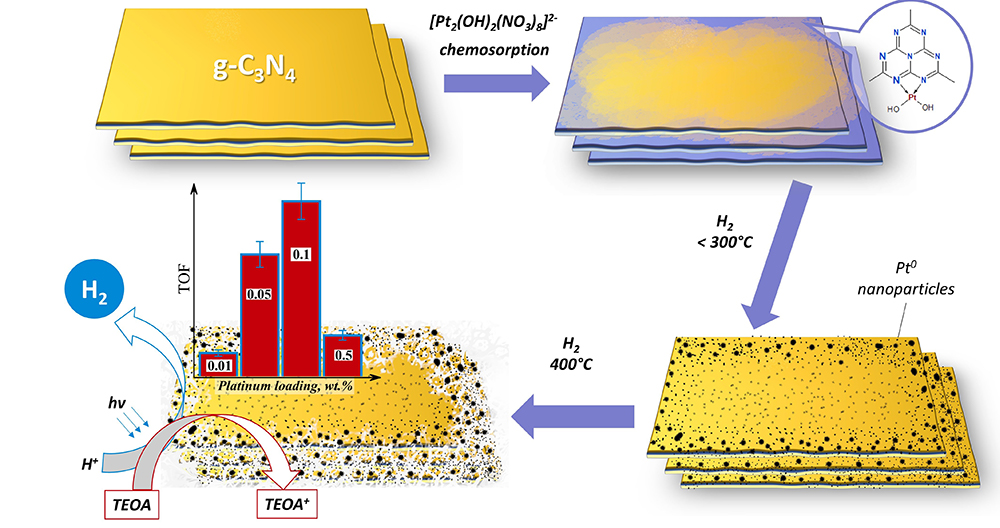
Phone: +7 (383) 330-67-71, Fax: +7 (383) 330-80-56, E-mail: bic@catalysis.ru
5 Lavrentiev Ave., 630090, Novosibirsk, Russia

Phone: +7 (383) 330-67-71, Fax: +7 (383) 330-80-56, E-mail: bic@catalysis.ru
5 Lavrentiev Ave., 630090, Novosibirsk, Russia
18 May 2022
The scientists from Boreskov Institute of Catalysis and Institute of Inorganic Chemistry supported by Russian Science Foundation developed photocatalysts for obtaining hydrogen under visible light based on graphite-like carbon nitride. Their advantage is in the ultra-low content of noble metals, even 0.01% of platinum allows significant increase in catalytic activity. The results of the study are published in Chemical Engineering Journal (impact-factor 13.273).
The researchers note that the obtained results would serve as a scientific foundation for development of prototypes of efficient devices for obtaining hydrogen under visible light. In practice it means that the developed approach can be seen in future as the basis for development of solar-hydrogen energetics.
The novelty of the study is in both method of synthesis and the way of supporting platinum on the carrier.
“We used a preliminary processing of the initial reagents and obtained the carrier of photocatalyst, graphite-like carbon nitride with high specific surface. Platinum was deposited from nitratocomplexes. This is a precision method of deposition that produced highly active materials with very low weight fraction of platinum. We started with 0.01% of platinum and showed that with this method even such low fraction of the active component significantly increases the photocatalytic activity”, says Dr. Prof. Ekaterina Kozlova, Leading Researcher of BIC, the author of the study.

Also the scientists paid attention to an interesting fact: during precipitation of the platinum complexes and reduction with hydrogen the structure of the carrier is partially calcinated, which brings about new pores. The specific surface of the material grows five times, and thus the activity of the photocatalyst increses.
“We reached not only very high activity, but also the growth of specific surface of the carrier to 290 m2/g, which is quite much for graphite-like carbon nitride. The usual methods yield 20-30 m2/g at best. We suggested method that simultaneously allows supporting platinum and increasing the surface of graphite-like carbon nitride in situ when supported”, explained Ekaterina Kozlova.

Graphical abstract
Along with the catalyst the researchers developed a prototype of a small reactor for producing hydrogen under visible light. The laboratory tests showed the working capacity of the reactor for a fuel element of 1 Wt. Scaling of the reactor is planned within the framework of the NTI Center of Competence “Hydrogen as Foundation for Low-Carbon Energetics” established in Boreskov Institute of Catalysis in 2021. The project, in particular, supposes development of larger reactors in 2023 as well as integrated system, reactor for hydrogen production plus hydrogen fuel element.
According to the scientist, in future a full-scale hydrogen-fuel processor that will supply hydrogen fuel element will be able to provide electricity for remote regions, where sunlight is intensive. This would require only sunlight and the reactor.
The researchers continue their work within the framework of RSF project.
“Now we obtained active photocatalysts that allow production of hydrogen from water solutions of organic substances, and the ultimate purpose of the RSF project for the nearest two years is to obtain the catalysts that would work in the process of complete photocatalytic destruction of water into hydrogen and oxygen”, added Ekaterina Kozlova.